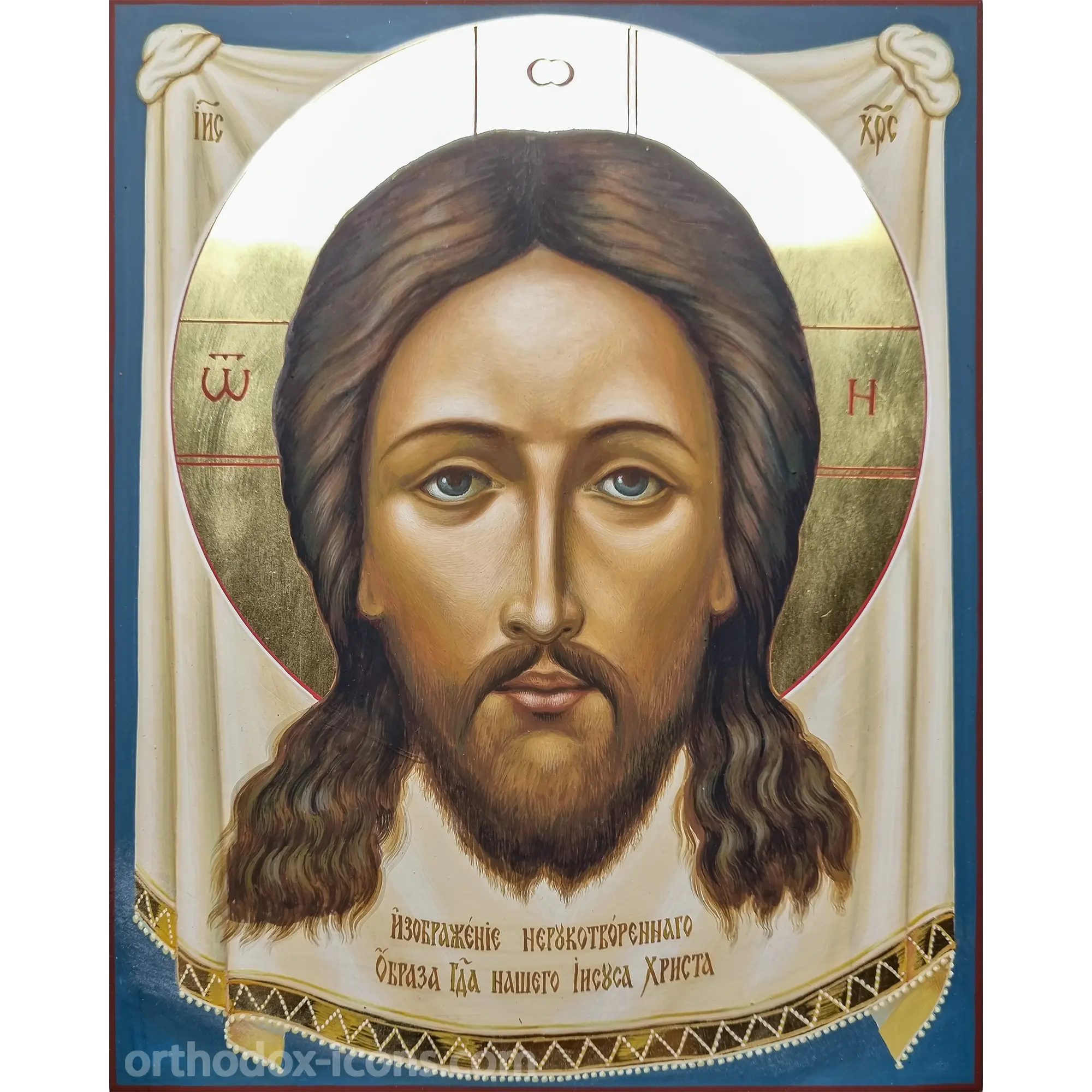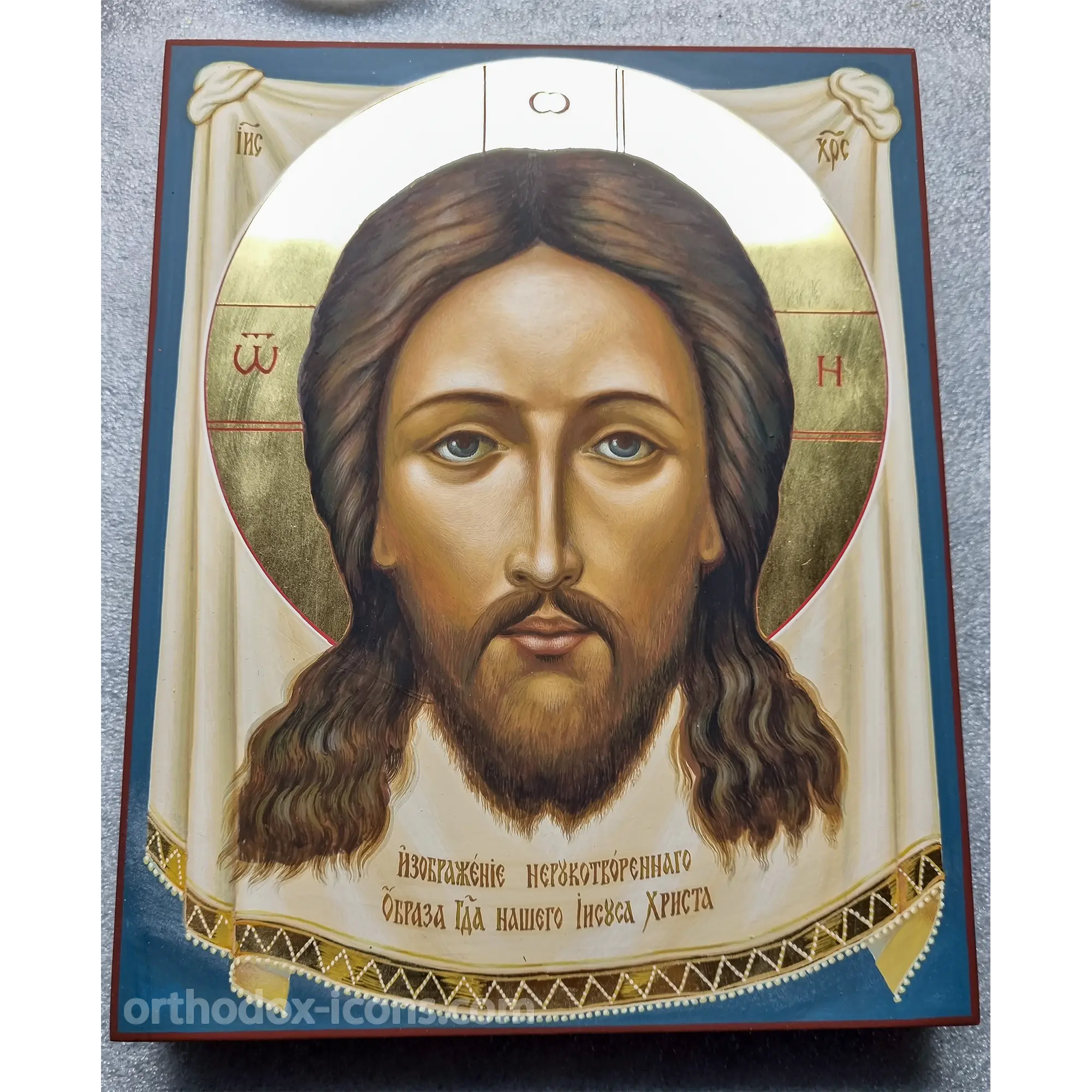Hand-Painted Icon of the Holy Face
$2600
30х50cm (11.8×19.7 in)
The Hand-Painted Icon of the Holy Face will be meticulously handcrafted for you at the Mstyora Icons Workshop, following the sacred traditions of Russian iconography.
-
Linden wood board with mortise-and-tenon joints for durability.
-
Natural materials: Pavoloka (linen), chalk levkas, 23K gold leaf (960 purity) by Manetti (Italy).
-
Egg tempera paints (handmade pigments on egg yolk).
-
Protective lacquer for longevity.
-
Hand-painted on wood by master iconographers.
-
Strict adherence to the Russian Orthodox canon.
-
Layered tempera application for luminous, enduring colors.
Each icon is a unique spiritual work of art, blessed by tradition and crafted with reverence.
It is possible to paint an image in any size to order
Available on backorder
Free shipping worldwide
Hand-Painted Christian Wall Art: The Holy Face (Spas Nerukotvorny)
This Hand-Painted Icon of the Holy Face (Spas Nerukotvorny) is created in strict accordance with Orthodox tradition, using natural mineral pigments in classic egg tempera technique on a seasoned linden board, enhanced with genuine gold leaf and intricate ornamental embossing. This sacred image depicts the miraculous Holy Face of Christ, also called the Mandylion—one of the most revered Orthodox icons, representing the “Image Not Made by Hands.” The arresting features and piercing gaze, surrounded by a radiant golden nimbus, create a powerful spiritual presence for prayerful contemplation and veneration.
Origin and Meaning of Spas Nerukotvorny: The Face “Not Made by Hands”
The Spas Nerukotvorny (Спас Нерукотворный), also known as the Mandylion or Image of Edessa, is one of the oldest and most profound icons in Christian tradition. According to Church legend, during Christ’s earthly ministry, King Abgar of Edessa sent a messenger to ask Jesus to come and heal him. Unable to reach Christ through the crowd, the messenger brought back a cloth imprinted with Christ’s image—miraculously left on the towel when Christ pressed it to His face. This became the first acheiropoieton—an image “not made by human hands.”
In Orthodox theology, the Holy Face is venerated as an authentic, miraculous witness to Christ’s incarnation, a testimony to God’s love and to the reality of the person of Jesus Christ. The icon’s gaze is both compassionate and direct, calling the viewer to a genuine encounter in prayer and repentance. Historically, it symbolized spiritual protection, was carried into battle, and prominently placed above city gates for blessing and safeguarding.
Distinguishing Features and Iconography
The Spas Nerukotvorny is renowned for its focus on Christ’s countenance. In this hand-painted version by Mstyora, traditional characteristics are faithfully preserved:
- Face of Christ: The icon depicts only the bust or the face, shown frontally, with a peaceful, penetrating gaze. The features are balanced: broad forehead, harmoniously arched eyebrows, large eyes, straight nose, and gently closed lips—expressing both truth and mercy.
- Crown of Thorns & Drops of Blood: This variant, sometimes known as “Spas v Ternovom Venze” (“Savior in the Crown of Thorns”), emphasizes Christ’s suffering and passion by including the crown and droplets of blood, reminding the viewer of His redemptive sacrifice.
- Mandylion and Gold Nimbus: The face is framed by an ornate golden halo, sometimes set against a cloth (mandylion), and always highlighted with finely tooled gold, drawing the faithful into a direct encounter with the divine.
- Absence of Narrative: The icon focuses exclusively on the Holy Face, with minimal or no background, ensuring the worshipper’s attention remains fixed on Christ’s presence.
Materials and Mastery: Why Mstyora Icons Stand Apart
Hand-Painted Icon of the Holy Face (Spas Nerukotvorny) from the Mstyora workshop exemplifies traditional Russian iconography at its best:
- Seasoned Linden Wood: The icon board is hand-prepared with linen and multiple chalk gesso (levkas) layers for long-lasting durability and ideal pigment adherence.
- 23K Gold Leaf: Each halo and border is burnished and tooled by hand, creating a luminous, protective radiance around the sacred image.
- Egg Tempera: Only natural mineral pigments are used, ensuring depth, subtlety, and spiritual “light from within.”
- Protective Finish: Icons are sealed with natural hybrid varnish, preserving color and gold brilliance for generations.
Theological and Personal Significance
The Spas Nerukotvorny carries deep spiritual meaning:
- God’s Incarnation: By contemplating the true, divine-human face of Christ, the faithful deepen their understanding of the Incarnation and God’s closeness to humanity.
- Prayer and Transformation: The direct gaze is both comforting and challenging, calling to repentance, healing, and inner change.
- Protection & Miracles: Historically, copies of this icon protected from plague, fire, and invasion. Possessing such an icon in the home is believed to bring blessing and spiritual defense.
- Liturgical Celebration: The Russian Orthodox Church commemorates the Miracle of the Holy Face (Spas Nerukotvorny) on August 16th (August 29th new style) with processions and prayers for deliverance and healing.
Icon Placement and Veneration
This icon is ideal for the central place in a home prayer corner, church sanctuary, or workplace. The prayer before the Holy Face is especially powerful for asking Christ’s mercy, forgiveness, health, and protection for oneself and loved ones. Whether before beginning the day or during moments of difficulty, the Holy Face is an inexhaustible source of comfort and strength.
Caring for Your Icon
- Keep away from direct sunlight and high humidity.
- Clean only with a dry, soft brush or cloth—no chemicals.
- Place reverently, ideally with a vigil lamp (lampada) beneath.
- On the feast day, join in prayers and processions for the Holy Face’s intercession.
Why Choose a Hand-Painted Icon?
Unlike prints, a hand-painted icon is a true sacramental object—each stroke an act of prayer, each material chosen for spiritual meaning as well as beauty. Having a hand-painted Spas Nerukotvorny in the home is to invite a perpetual, transformative encounter with Christ Himself, and to honor centuries of tradition and faith.
Questions and Answers
Q: What is the meaning of “Spas Nerukotvorny”?
A: It means “Savior Not Made by Hands”—an icon believed to be a miraculous imprint of Christ’s face, not created by human artists.
Q: What is the origin of the Holy Face icon?
A: Tradition says Christ left His image on a cloth for King Abgar of Edessa, creating the first icon “not made by hands,” also called the Mandylion.
Q: Why is the crown of thorns shown in some versions?
A: The “Spas v Ternovom Venze” variant includes the crown and blood to focus on Christ’s sufferings and the passion.
Q: What is the spiritual benefit of having this icon?
A: It is considered a source of blessing, protection, and a means of deepening one’s personal prayer and repentance through Christ’s gaze.
Q: Is the Spas Nerukotvorny the same as the Mandylion?
A: Yes—the Mandylion is another name for the same image, focusing on its origin as a miracle cloth.
Q: How is the icon used in Orthodox worship?
A: It is placed on analogions, processed during feasts, prayed before for healing and deliverance, and used for home veneration.
Q: What materials are used in this hand-painted icon?
A: Seasoned linden wood, chalk levkas, egg tempera, 23K gold leaf, and natural varnish, entirely hand-crafted in accordance with Orthodox canon.
Q: How to properly care for and display the icon?
A: Avoid sunlight and moisture, dust gently, place in a prayerful area, and honor with a vigil lamp if possible.
Q: When is the liturgical feast of the Holy Face?
A: August 16th (29th new style) is the Russian Orthodox feast of the Miracle of the Holy Face (Spas Nerukotvorny).
Q: Why is the gaze of the icon so important?
A: The direct gaze is meant to invite repentance, healing, and a transformative, personal encounter with the living Christ.
| Dimensions | 30x50cm (11.8×19.7 in) |
|---|---|
| Name | Jesus |
Related products
The Theophany Orthodox Icon
Available on backorder
$200 – $990Price range: $200 through $990Pantocrator Christ Orthodox Icon
Available on backorder
$200 – $990Price range: $200 through $990Orthodox Icon of Christ
Available on backorder
$300 – $1400Price range: $300 through $1400The Lord Orthodox Icon
Available on backorder
$200 – $990Price range: $200 through $990Jesus Orthodox Icon
Available on backorder
$300 – $1400Price range: $300 through $1400
